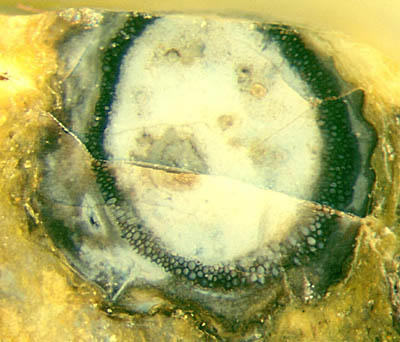 Ventarura
Ventarura
The fossil plant seen here on a cross-section of a small sample found in 1998 had remained enigmatic until a first publication
on Ventarura appeared
in 2000 [1]. Incidentally, this sample with the first own find of Ventarura contains also an incurved tip like that of most ferns, which has remained the only one ever seen: Rhynie
Chert
News 3.
Among the Higher Plants in the Rhynie
chert, Ventarura
had been discovered last. It was thought to be restricted to a separate and narrowly
localized variety of the Rhynie chert, named Windyfield chert. (Hence
the name Ventarura, which means "windy field".) This assumption has turned out not true. All own finds of Ventarura are from other sites.
Like the previously discovered Trichopherophyton,
Ventarura belongs to the
zosterophylls, a group of plants widely distributed in the Lower
Devonian.
The distinctive feature, a concentric tube with well seen
cellular
structure while all other tissue had virtually vanished, is found
only in the upper parts of the plant which seem to be less often
preserved. This persistent tube, seen on cross-sections as a nearly circular ring
contrasting to the mostly shrivelled outside, is often conspicuous for its apparently strong cell walls with dark
stain. Its original interpretation as sclerenchyma [1,2] is rejected
here: Rhynie Chert
News 60
, 82,
174.
Ventarura parts
without a ring on cross-sections are usually
not recognized as such. Even Ventarura sections
with ring may escape notice if the outline is not rugged but
smoothly circular and the cell walls are not stained dark but pale:
Rhynie
Chert
News 58.
One or more younger shoots inside an older one most probably
indicate a zosterophyll. (See Rhynie
Chert
News
16.)
Hollow straws of Aglaophyton
with layers of
well-preserved cells
below the surface may
easily be (and really had been) mistaken for Ventarura:
Rhynie Chert
News 66.
In order
to tell Ventarura from Aglaophyton cross-sections,
the following rules can be helpful:
It is Ventarura
if the ring of well-seen cells is ...
... (nearly) circular but the outline of the
section is rugged,
... well away from the outline,
It is virtually never Ventarura
if the epidermis is still there: Rhynie Chert
News 61,
91.
It is not known
whether the decay-resistant tube amidst the cortex makes Ventarura unique or
is present in some other fossil or extant plant, too. The hollow straw
aspect occasionally seen with Aglaophyton,
well known but misinterpreted, is possibly brought about by essentially
the same sequence of processes and hence can lead to an explanation of
the conspicuous phenomenon in either plant:
Rhynie
Chert News 83.
Judging from more than a dozen small chert samples with Ventarura found
hitherto, this plant seems to be more widely distributed in the chert
but had been overlooked. Hence, more finds are likely, which may help
to answer the remaining questions raised by the peculiar features of
this fossil.
A cross-section with unique aspect is shown in Rhynie Chert
News 96.
Considering that Ventarura
and Trichopherophyton
are the least abundant ones among the land plants in the Rhynie chert,
the presence of the two zosterophylls in one chert sample must be a
rare coincidence:
Rhynie
Chert News 95.
As a surprise, a raw sample surface shows a picturesque section of Ventarura with the
xylem seen most clearly:
Rhynie
Chert News 171
.
Sample: Rh3/5 (0.2kg) Part5, found in 1998.
H.-J.
Weiss
2012,
emended 2014, 2016, 2021.
[1] C.L. Powell,
D. Edwards, N.H. Trewin:
A new
vascular
plant from the Lower Devonian Windyfield chert, Rhynie,
Trans. Roy. Soc.
Edingurgh, Earth Sci. 90 (2000 for 1999), 331-349.
[2] H. Kerp, H.
Hass: Ökologie
und Reproduktion der frühen Landpflanzen. Ber.
d. Reinh.-Tüxen-Ges. 21, 111-127. Hannover 2009.
 Ventarura
Ventarura